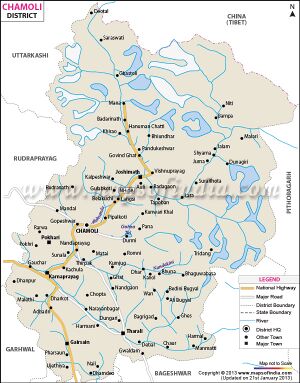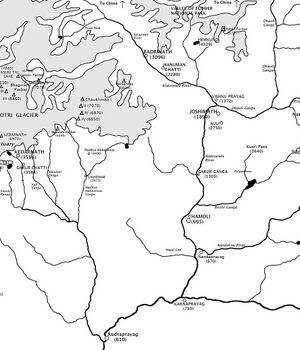Badrinath
| Author:Laxman Burdak, IFS (R) |


Badrinath (बद्रीनाथ) is an ancient religious place in Chamoli district in Uttarakhand. It is the most important of the Char Dham pilgrimage and gets its name from the Holy temple of Badrinath.
Variants
- Badari बदरी = Badari Ashrama बदरी आश्रम =Badarinath बदरीनाथ, उ.प्र., (AS, p.605)
- Badri Vishala (बद्री विशाला) (AS, p.605)
- Badarikashrama बदरिकाश्रम= badarinath बदरीनाथ (AS, p.605)
- Badrinath बद्रीनाथ दे. Badarinath बदरीनाथ (AS, p.607)
- Badrikashrama (बद्रिकाश्रम)
- Badarikashram (बदरिकाश्रम)
- Vishālā विशाला (3) = Badrinath (बदरीनाथ) (AS, p.864)
- Badrinarayana (बद्रीनारायण) (AS, p.931)
Origin of name
Badari is the Sanskrit name for the Indian Jujube tree, which has an edible berry. Some scriptural references refer to Jujube trees being abundant in Badrinath.
Location
Badrinath is located 62 km northwest of Nanda Devi peak and 301 km north of Rishikesh. From Gaurikund (near Kedarnath) to Badrinath by road is 233 km.
Badrinath has an average elevation of 3,100 metres (10,170 feet). It is in the Garhwal Himalayas, on the banks of the Alaknanda River. The town lies between the Nar and Narayana mountain ranges 9 km east of Nilkantha peak (6,596m).
History
According to the Bhagavata Purana, "There in Badrikashrama the supreme being (Vishnu), in his incarnation as the sages Nara and Narayana, had been undergoing great penance since time immemorial for the welfare of all living entities." (Bhagavata Purana 3.4.22)
Badrinath was re-established as a major pilgrimage site by Adi Shankara in the ninth century. In earlier days, pilgrims used to walk hundreds of miles to visit Badrinath temple. The temple in Badrinath is also a sacred pilgrimage site for Vaishnavites. Badrinath is also gateway to several mountaineering expeditions headed to mountains like Nilkantha.
The Badrinath area is referred to as Badari or Badarikashram (बदरिकाश्रम) in Hindu scriptures. It is a place sacred to Vishnu, particularly in Vishnu's dual form of Nara-Narayana. Thus, in the Mahabharata, Krishna, addressing Arjuna, says, "Thou wast Nara in a former body, and, with Narayana for thy companion, didst perform dreadful austerity at Badari for many myriads of years." [1][2]
One legend has it that when the goddess Ganga was requested to descend to earth to help suffering humanity, the earth was unable to withstand the force of her descent. Therefore the mighty Ganga (Ganges) was split into twelve holy channels, with Alaknanda one of them.
Another Legend explains both name and sitting posture as this place was full of Badri bushes and Vishnu meditating for, beloved Lakshmi stood next to him sheltering him from scorching sunlight turned into a Badri herself called 'Badri Vishala' and her lord (Nath) became the Badrinatha.
The mountains around Badrinath are mentioned in the Mahabharata, when the Pandavas were said to have expired one by one, when ascending the slopes of a peak in western Garhwal called Swargarohini.(literal meaning - the 'Ascent to Heaven'). The Pandavas passed through Badrinath and the town of Mana, 4 km north of Badrinath, on their way to Svarga (heaven). There is also a cave in Mana where Vyasa, according to legend, wrote the Mahabharata.[3]
The area around Badrinath was celebrated in Padma Purana as abounding in spiritual treasures.[4]
In Mahabharata
Badari (बदरी) (Tirtha) (I.32.3), (III.174.11)
Adi Parva, Mahabharata/Mahabharata Book I Chapter 32 mentions many names Nagas and their deeds after the curse. Badari (बदरी) (Tirtha) is mentioned in Mahabharata (I.32.3).[5]....The illustrious Sesha (I.32.2) amongst them, of great renown, leaving his mother practised hard penances, living upon air and rigidly observing his vows. He practised these ascetic devotions, repairing to Gandhamadana (I.32.3), Badari (I.32.3), Gokarna (I.32.3), the woods of Pushkara i.e. Pushkararanya (पुष्करारण्य) (I.32.3), and the foot of Himavat (I.32.3).
Vana Parva, Mahabharata/Book III Chapter 174 describes Pandvas journey in twelfth year of their sojourn in forests having arrived reach Saraswati River. Badari (बदरी) (Tirtha) is mentioned in Mahabharata (III.174.11).[6]....Then all those warriors (Pandavas) having in due course happily lived at Badari for one month, proceeded towards the realm of Suvahu, king of the Kiratas...
बदरी = बदरी आश्रम = बदरीनाथ
विजयेन्द्र कुमार माथुर[7] ने लेख किया है .....बदरी = बदरी आश्रम = बदरीनाथ, उ.प्र., (AS, p.605): बदरिकाश्रम उत्तराखण्ड राज्य के गढ़वाल के अन्तर्गत एक प्रसिद्ध हिन्दू तीर्थ स्थल है.
महाभारत काल में बद्रीनाथ की तीर्थ रूप में मान्यता प्रतिष्ठित हो गई थी. पांडवों ने भारत के अन्य तीर्थों की भांति बद्रीनाथ की भी यात्रा की थी-- 'एवं सुरमणीयानि वनान्युपवनानि, आलोकयन्तस्ते जग्मुर्विशालां बदरीं'--वनपर्व 145,11. इस उल्लेख में बद्रीनाथ को विशाला नाम से अभिहित किया गया है जो आज भी पूर्ववत प्रचलित है ('बद्री विशाला') इस यात्रा में पांडवों ने अनेक प्रकार के पशु-पक्षियों तथा अनेक नदियों को देखा था--'मयूरैश्चभरैश्चैव वानरैरुरुभिस्तथा, वराहैर्गवयैश्चैव महिषैश्च समावृतान्, नदीजालसमाकीर्णान्नानापक्षियुतान्बहून्, नानाविधमृगैर्जुष्टान् वानरैश्चोपशोभितान्. वनपर्व 145, 15-16.
बद्रीनाथ में गंगा की उपस्थिति महाभारत में वर्णित है -- 'एषा शिवजला पुण्या याति सौम्य महानदी, बदरी-प्रभवाराजन् देवर्षिगणसेविता' महाभारत वन पर्व 142,4. यहां गंगा को बद्रीनाथ से उद्भूत माना है क्योंकि गंगोत्री बद्रीनाथ से कुछ ही दूर है. वनपर्व 139,11 में विशाला को कैलाश के निकट माना है--'कैलासः पर्वतो राजन्पड्योजनशतोच्छ्रितः, यत्रदेवाः समायान्ति विशाला यत्र भारत'
बद्रीनाथ में नर नारायण के स्थान (जो आज भी है) और भागीरथी का वर्णन भी महाभारत में है--'तत्रापश्यत्स धर्मात्मा देवदेवर्पिपूजितम्, नरनारायणस्थानं भागीरथ्योपशोभितम्'--वनपर्व 145,41.
शांति पर्व 127,3 में बद्रीनाथ के निकट वैहायसकुंड का उल्लेख है जो संभवत है वैहायसी या आकाश मार्ग से जाने वाली गंगा का ही कुंड है--'आकाशगङ्गां प्रयताः पाण्डवास्तेऽभ्यवादयन्' वनपर्व 142,11.
बद्रीनाथ में महाभारत के आदिकर्ता महर्षि व्यास का मुख्य आश्रम था इसीलिए उन्हें बादरायण कहा जाता है. बद्रीनाथ में व्यास गुफा नामक स्थान को ही याद का निवास स्थान माना जाता है और यह भी किंवदंती है कि महाभारत की रचना उन्होंने [p.606]: वहीं की थी. परवर्ती काल में शंकराचार्य बद्रिकाश्रम में कुछ समय ठहरे थे. बौद्ध जनश्रुति के अनुसार शंकराचार्य से पहले बद्रीनाथ में बौद्धों का मंदिर था और इसमें बुध की मूर्ति स्थापित थी.
बदरी
बदरी गंगा नदी के तट पर हिमालय की गोद में स्थित एक अत्यन्त पवित्र तीर्थस्थल है। गंगा तट पर नर और नारायण का आश्रम और तीर्थस्थल होने से इसे 'बद्रिका' या 'बद्रीधाम' भी कहा गया है। यहाँ अमृत तुल्य शीतल जल वाली गंगा उष्ण जल वाली धारा बन जाती है और स्वर्ण बालुका बहाकर लाती है। इससे आगे मेरु, कैलास और गंधमादन पर्वत हैं। वनवास काल में गंगाद्वार (हरिद्वार) को पार करते हुए पांडवों ने अनेक रमणीक हिमाच्छादित शैल शिखर देखे थे। विशाल बेर वृक्षों से आवृत्त बदरी के दर्शन किए, जो हिमवत की गोद में स्थित हैं। यहाँ से वे गंधमादन पर पहुँचे थे। स्वर्ग से अर्जुन आगमन के अनंतर गंधमादन से लौटकर यहाँ एक माह तक वास किया। [8]
संदर्भ: भारतकोश-बदरी
चक्रतीर्थ
विजयेन्द्र कुमार माथुर[9] ने लेख किया है ...2. चक्रतीर्थ (AS, p.325): जिला गढ़वाल उत्तर प्रदेश में बद्रीनाथ से कुछ दूर उत्तर की ओर स्थित है. उसके विषय में पौराणिक किंवदंती है कि यहां रहकर अर्जुन ने तप किया था और वरदान स्वरूप दैवी अस्त्र प्राप्त करके उन्होंने शत्रु पर विजय प्राप्त की थी-- 'चक्रतीर्थस्य महात्मादअर्जुन: परमास्त्रवित् भूत्वा स नाशयामास शत्रून् दुर्योधनादिकान्' स्कंद पुराण, केदारखंड, 58,57
मंदराचल
विजयेन्द्र कुमार माथुर[10] ने लेख किया है ...मंदराचल (AS, p.688): 'श्वेतं गिरिं प्रवेक्ष्यामो मंदरं चैव पर्वतं, यत्र मणिवरौ यक्ष: कुबेरश्चैव यक्षराट्'-- महाभारत 139,5. इस उद्धरण में मंदराचल का पांडवों की उत्तराखंड की यात्रा के संबंध में उल्लेख है जिससे यह पर्वत हिमालय में बद्रीनाथ या कैलाश के निकट कोई गिरि-श्रंग जान पड़ता है. विष्णु पुराण 2.2.16 के अनुसार मंदर पर्वत इलावृत के पूर्व में है-- 'पूर्वेण मंदरोनाम दक्षिणे गंधमादन:' मंदराचल का पुराणों में क्षीरसागर-मंथन की कथा में भी वर्णन है. इस आख्यायिका के अनुसार सागर-मंथन के समय देवताओं और दानवों ने मंदराचल को मथनी बनाया था.
Rule of Salivahan descendants in Badrinath
James Tod writes that In the mountains of Badrinath, there was a state, whose princes were of the Yadu race, descended from the first Salivahan (S.72 = AD 16) at the period of the expulsion from Ghazni. At this time, the prince of this state dying without issue, a deputation came to Jaisalmer to obtain a prince to fill the vacant gadi. Hasso (A.D. 1200) was accordingly sent, but died just as he arrived. His wife, who was pregnant, was taken with the pains of labour on the journey, and was delivered of a son under the shade of a palas tree, whence the child was called Palasia. This infant succeeding, the raj (principality) was named after him Palasia. [11]
See also
External links
References
- ↑ Dowson's Classical Dictionary of Hindu mythology
- ↑ Gopal, Madan (1990). K.S. Gautam, ed. India through the ages. Publication Division, Ministry of Information and Broadcasting, Government of India. p. 75.
- ↑ Nautiyal, Govind Prasad, Call of Badrinath, Shri Badrinath-Kedarnath Temples Committee, 1962.
- ↑ Nautiyal, Govind Prasad, Call of Badrinath, Shri Badrinath-Kedarnath Temples Committee, 1962.
- ↑ गन्धमादनम आसाद्य बदर्यां च तपॊ रतः, गॊकर्णे पुष्करारण्ये तथा हिमवतस तटे (I.32.3)
- ↑ ततः करमेणॊपययुर नृवीरा; यदागतेनैव पदा समग्राः, विहृत्य मासं सुखिनॊ बदर्यां; किरात राज्ञॊ विषयं सुबाहॊः (III.174.11)
- ↑ Aitihasik Sthanavali by Vijayendra Kumar Mathur, p.605
- ↑ महाभारत, आदिपर्व, अध्याय 36, वनपर्व, अध्याय 40, 47, 90, 115, 141, 156.
- ↑ Aitihasik Sthanavali by Vijayendra Kumar Mathur, p.324-325
- ↑ Aitihasik Sthanavali by Vijayendra Kumar Mathur, p.688
- ↑ James Tod: Annals and Antiquities of Rajasthan, Volume II, Annals of Jaisalmer, p.222-223

